Wild hydrangea (
Hydrangea arborescens)
and its cultivars are landscape staples that grace gardens across the U.S. and around the world. With their mounding habits and long-lasting flowers, it’s easy to see why. For landscape purposes, the cultivars have stronger forms and showier flowers. In a more naturalistic setting, the smaller flowers and looser shape of the wild type may be more appropriate.
These flowering perennials are easy to grow, tolerating a wide range of sun exposures and soil conditions. Additionally, wild hydrangea blooms on new wood, so flowering isn’t affected by the winter cold that wreaks havoc on many of the introduced hydrangeas (
H. macrophylla) in colder climates.
Caution: Leaves, buds and flowers are toxic to people and pets, and can be harmful if consumed in sufficient quantities.
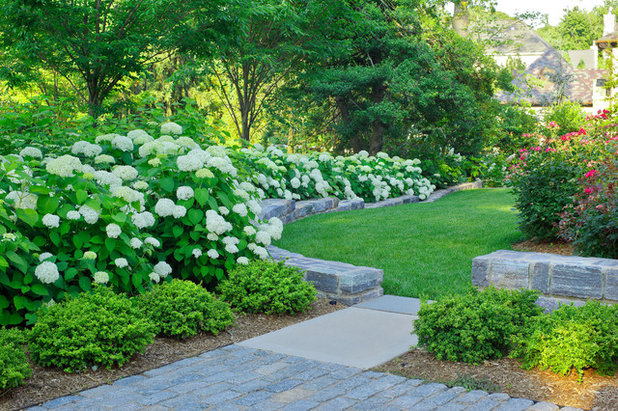
Katia Goffin Gardens
Botanical name: Hydrangea arborescensCommon names: Wild hydrangea, smooth hydrangea, sevenbark, hills of snow
Origin: Native from eastern Kansas east to southern New York in the north and Louisiana and northern Florida in the south
Where it will grow: Hardy to minus 40 degrees Fahrenheit, or minus 40 degrees Celsius (USDA zones 3 to 9; find your zone)
Typical plant communities: Found in the wild along streams and on moist wooded slopes and ravines
Water requirement: Prefers moist (not wet) loamy soils; tolerates a range of soil moistures, from wet-mesic to mesic-dry
Light requirement: Prefers part sun but tolerates full sun if given consistent moisture; can handle more sunlight in its northern range; has good tolerance for shade
Mature size: Mounding shrub, typically 3 to 5 feet tall and wide
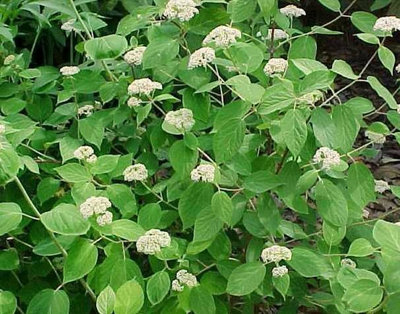
Missouri Botanical Garden
The wild type of Hydrangea arborescens has smaller flower clusters and a more relaxed form than the cultivars.
Benefits and tolerances: Helps prevent erosion; tolerates clay and alkaline soils (to pH 8.5); ignored by rabbits; grows under black walnut trees
Seasonal interest: Puts up a dense layer of foliage from midspring well into fall; flowers from late spring through much of summer
When to plant: Container plants in spring or fall; divisions in early spring before the plant fully leafs out
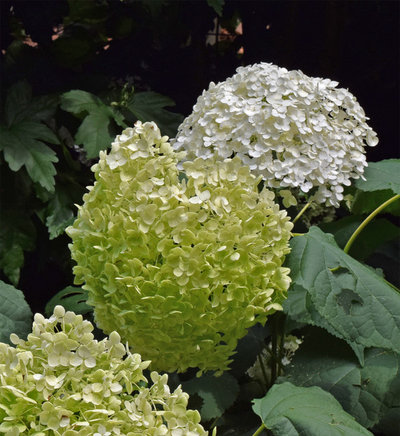 Hydrangea arborescens ‘Annabelle’ in mid-July sports a younger white bloom in the back and an older bloom that’s turning green in the middle. Distinguishing traits.
Hydrangea arborescens ‘Annabelle’ in mid-July sports a younger white bloom in the back and an older bloom that’s turning green in the middle. Distinguishing traits. Unlike many of the big-leaf hydrangeas (
H. macrophylla) in the nursery, wild hydrangea and its cultivars bloom on new wood, or stems that grow up in the current growing season. This means that you will get a full crop of flowers no matter how cold or difficult the winter was.
The fertile flowers of the wild form are small (one-eighth inch) and grouped in the center of each flat-topped cluster. These are surrounded by much larger (one-half- to three-quarter-inch) sterile florets. Plants that you are most likely to see in the garden center are cultivars that have been selected for larger, but sterile, flowers.
Wild hydrangea is a suckering shrub, putting up multiple canes from its shallow roots. The leaves are relatively large (3 to 7 inches), ovate to heart-shaped and are oppositely arranged on the stems. These large leaves on the dense arrangement of stems result in a very dense canopy, shading out most anything trying to grow underneath. Each cane will bear a terminal flower cluster. If stems are allowed to grow for a couple of seasons, they develop peeling bark covering a darker orange inner bark.
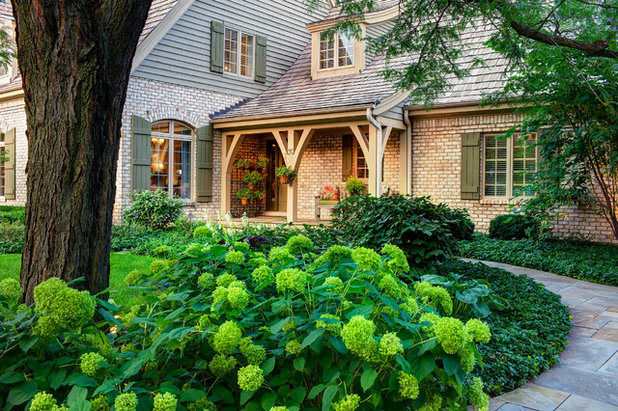
Hursthouse Landscape Architects and Contractors
‘Annabelle’ wild hydrangea grows along the entry path of this Chicago garden. How to use it. Wild hydrangea makes a good border plant, forming a dense mound of foliage and flowers. It could be grown close to a driveway or walkway where snow would be piled, since it’s usually cut near the ground when done flowering and is cold- and salt-tolerant. It’s also a good choice for a shaded garden. Although it doesn’t like constant wetness, its tolerance for a range of soil moistures could make it a good choice for a rain garden, particularly along the middle or upper levels. Wild hydrangea would also do well near a concrete foundation, since it can tolerate some soil alkalinity.
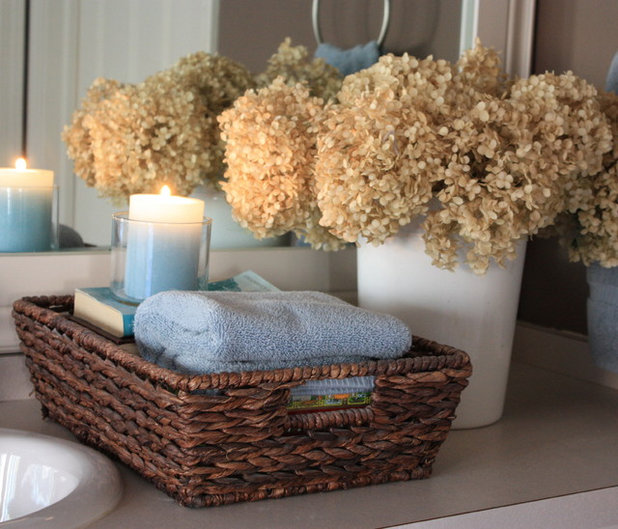
The Yellow Cape Cod
As the flower ages, it goes from bright white to a pale lime green. At this time, the flower heads can be cut off and dried. Cut the stem a foot or so down from the flowers, then strip off the leaves. Hang these stems upside down in a dry area until the flowers turn a buff color. These are effective in indoor arrangements and can last for years.
Alternatively, you can leave the greenish flower heads in place through the summer as an ingredient in a green-themed garden. In fall, the flowers will turn buff and persist until the winter weather breaks them apart.
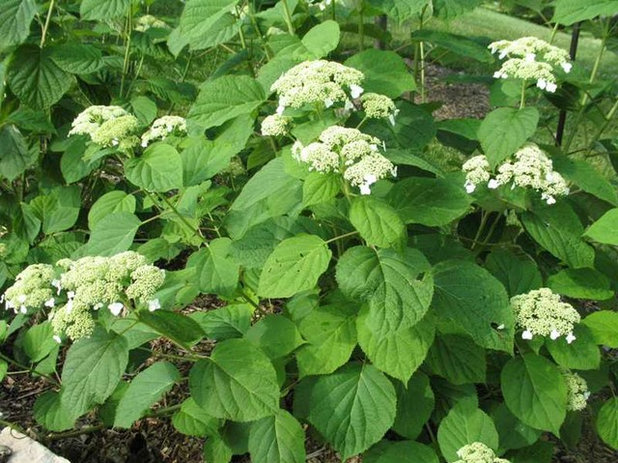
Missouri Botanical Garden
White Dome wild hydrangea (H. arborescens ‘Dardom’) is a popular cultivar. Planting notes. In warmer southern gardens, wild hydrangea will need more shade and water in a sunny site.
Wild hydrangea is usually treated as a perennial and cut down to the ground each winter or early spring. This promotes the growth of more canes that are stronger. Allowing canes to grow for more than a season can lead to some interesting peeling bark, but these stems can also start flopping over due to the heavy flowers and foliage the stems support.
Individual plants are not long-lived, but each plant spreads by root suckers. Masses tend to expand over time under favorable growing conditions.
Cultivars. A number of cultivars of wild hydrangea are available in the nursery trade. You will more likely find them listed under the name smooth hydrangea or as one of the cultivar or commercial names. However,
Hydrangea arborescens should be written somewhere on the label.
‘Annabelle’ is probably the most popular cultivar, featuring large domes of long-lasting white flowers. It was originally discovered growing in the wild near Anna, Illinois. ‘Grandiflora’ is a similar cultivar and also features large flowers. ‘Dardom’, sold under the trademarked name White Dome, has more of a lace-cap bloom, with a ring of sterile flowers surrounding a large mass of fertile flowers.
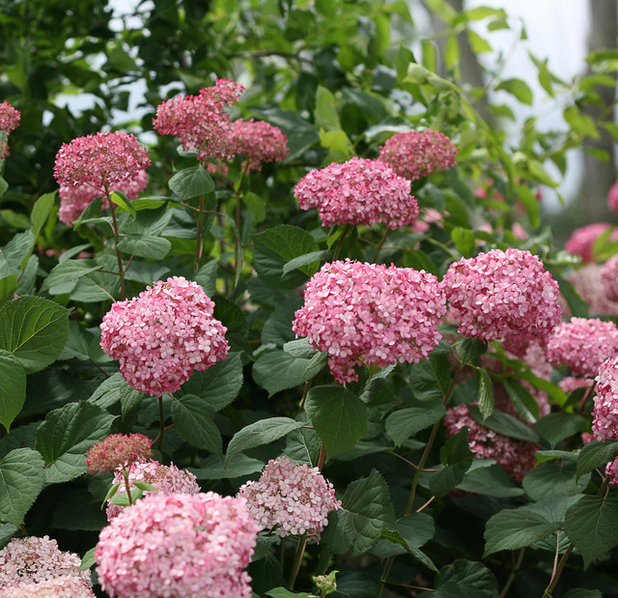
Proven Winners
There are also several selections with pink flowers. Invincibelle Spirit II wild hydrangea (H. arborescens ‘NCHA2’), shown here, is an example. Cultivars with large flowers benefit from additional support as they are growing. Peony cages or a web of strings about 2 feet off the ground will help keep the plants upright even in heavy rains. By deadheading the first flush of flowers in July, a second flush of flowers may be induced for September.
Wild hydrangeas are pollinated by many species of native bees and beetles. They are also host plants for the hydrangea sphinx moth. To provide the greatest benefit to pollinators, selections bearing more fertile flowers, such as ‘Dardom’ or wild-type plants, should be used.
More:20 Ways to Work White Magic in Your Yard
See how to grow another native hydrangea
Browse plants native to other regions of the U.S.





